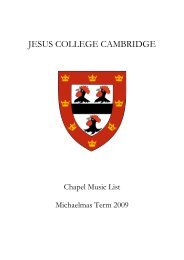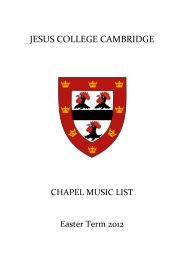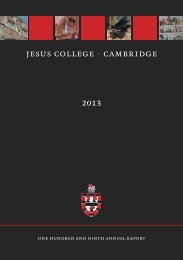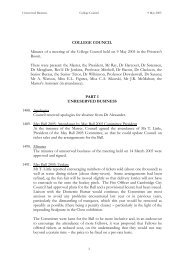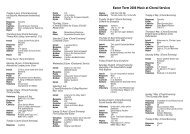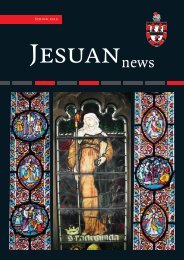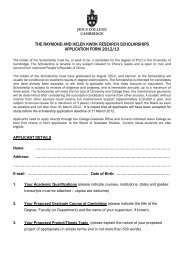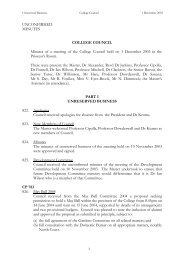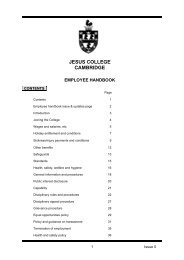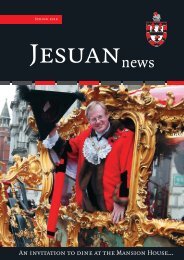2012 Annual Report - Jesus College - University of Cambridge
2012 Annual Report - Jesus College - University of Cambridge
2012 Annual Report - Jesus College - University of Cambridge
You also want an ePaper? Increase the reach of your titles
YUMPU automatically turns print PDFs into web optimized ePapers that Google loves.
46 DICKENS AND JESUS I <strong>Jesus</strong> <strong>College</strong> <strong>Annual</strong> <strong>Report</strong> <strong>2012</strong><br />
however, he had made his pr<strong>of</strong>essional mark<br />
and had a private practice bringing in a very<br />
large annual income. Yet the Elliotson<br />
Dickens came to know in the late 1830s at the<br />
time <strong>of</strong> the success <strong>of</strong> Pickwick Papers was now<br />
taking innovation too far: he had espoused<br />
the cause <strong>of</strong> mesmerism. The creation <strong>of</strong> the<br />
Viennese society doctor Franz Mesmer in the<br />
latter half <strong>of</strong> the nineteenth century,<br />
mesmerism involved belief in the existence <strong>of</strong><br />
a universally distributed, highly rarefied fluid.<br />
Suffused by this fluid, the human body<br />
suffers from blockages <strong>of</strong> its ebb and flow,<br />
from imbalance in its circulation through the<br />
body and between body and world.<br />
Mesmerism as a practice, treated the<br />
resulting disorders by intervening to<br />
redistribute the fluid, thereby correcting<br />
imbalance, removing blockages, and<br />
re-establishing harmony. This the<br />
practitioner did by channelling magnetic<br />
fluid from his own body to that <strong>of</strong> the person<br />
treated, either by touching the affected areas<br />
or by having the person touch things<br />
previously magnetized, or simply by making<br />
gestures – so many ‘passes’ – with the hands.<br />
That all this had nothing to do with any fluid<br />
but rather with forms <strong>of</strong> hypnotic suggestion,<br />
with the power <strong>of</strong> the mind over the body,<br />
was only tentatively beginning to be<br />
understood.<br />
In 1837, Elliotson attended demonstrations<br />
<strong>of</strong> mesmerism in London by a<br />
French practitioner and was enthusiastic as<br />
to its possibilities. So much so that he began<br />
to use it in his hospital wards, himself acting<br />
as mesmeriser. He also gave public<br />
demonstrations, designed to show<br />
mesmerism’s powers and combat the<br />
ignorance <strong>of</strong> its critics. The demonstrations,<br />
first in the wards themselves and then in the<br />
hospital’s lecture theatre, were attended by a<br />
public that was not confined to medical<br />
practitioners and students; peers <strong>of</strong> the<br />
realm, bishops, MPs, writers, artists could be<br />
seen in attendance, Dickens among them. In<br />
these demonstrations, as well as in sessions<br />
held in his Conduit Street home, Elliotson<br />
used some <strong>of</strong> his hospital patients, notably<br />
two young sisters who had been admitted for<br />
epileptic symptoms and were now Elliotson’s<br />
star turns: Jane and Elizabeth Okey.<br />
Mesmerised, the sisters went into<br />
convulsions, fell into somnambulistic states,<br />
became insensitive to pain, did ‘sleep<br />
writing’, and much more. On one occasion<br />
Elizabeth babbled <strong>of</strong> a man jumping naked<br />
out <strong>of</strong> bed; on another she plumped herself<br />
on a peer’s lap and tried to run her hand up<br />
his trousers. She was apparently sensitive to<br />
the magnetic condition <strong>of</strong> the patients<br />
around her and believed by Elliotson to<br />
possess prognostic powers. She would see<br />
‘Jack’, ‘the angel <strong>of</strong> death’, hovering over<br />
other patients. Disregarding all propriety,<br />
Elliotson took her at dusk into the men’s<br />
wards to get her predictions as to how the<br />
patients there would fare.<br />
Scandal was inevitable. The hospital<br />
authorities were outraged at this bringing <strong>of</strong><br />
the hospital into disrepute – unscientific<br />
theories, irregular methods, and potential, if<br />
not actual, immorality, involving practices on<br />
young women put into a state where they lost<br />
control over their actions. The scandal was<br />
fuelled by the Lancet. Founded in 1823 by the<br />
radical ex-surgeon Thomas Wakley, now MP<br />
for Finsbury, the journal was not the<br />
altogether respectable journal <strong>of</strong> today. It had<br />
gained its success by pirating lectures given<br />
by the hospital teachers, thereby saving<br />
students the fees they would have to pay to<br />
attend them (6 guineas for a course, 6d a<br />
week for the journal). The journal’s<br />
fundamental aim was medical reform and<br />
Wakley pulled no punches in his attacks on<br />
the medical establishment – an annual<br />
lecture at the Royal <strong>College</strong> <strong>of</strong> Surgeons was<br />
merely ‘the usual twaddle uttered on such<br />
occasions’, the leading London surgeons<br />
themselves were referred to as ‘the bats’ on<br />
account <strong>of</strong> their blindness and the damage<br />
done by their claws (Wakley was hot on<br />
bungled operations).<br />
Naturally mesmerism attracted Wakley’s<br />
critical attention. Relatively open-minded<br />
reports <strong>of</strong> the demonstrations appeared in<br />
1837, but by the following year Wakley had<br />
taken up the topic with his usual vigour,<br />
setting up experimental trials to test the<br />
theory and expose the practice. Mesmerists<br />
believed that the magnetic fluid could be<br />
transmitted through certain especially<br />
receptive conductors – water, for instance, or



